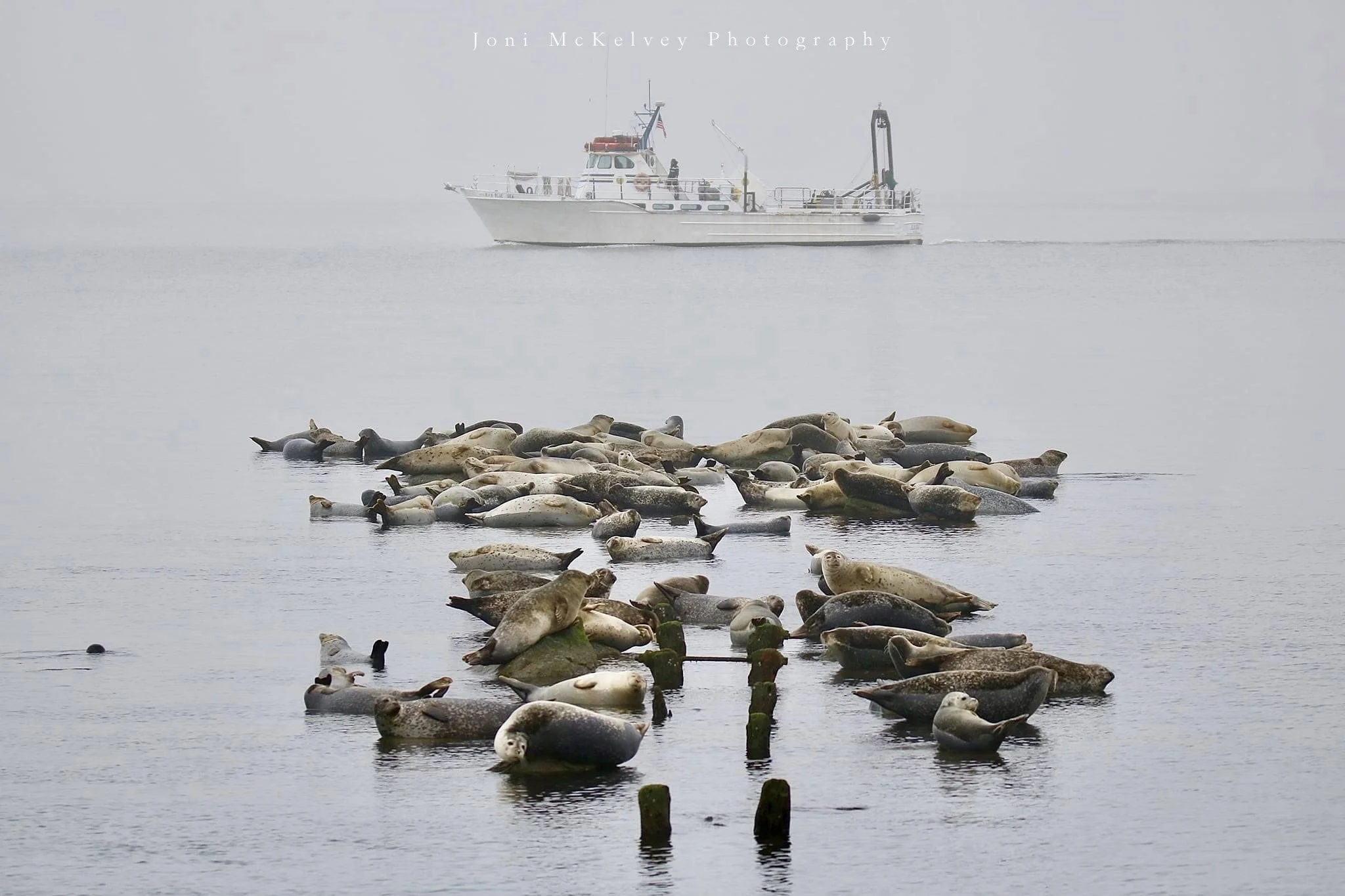Seals of Sandy Hook
SEALS OF SANDY HOOK
Written by Kristine Manganelli-Rappaport (Somerset County 4-H Program Coordinator)
Seals in Sandy Hook - Photo courtesy of Joni McKelvey Photography
March has arrived, ushering in longer days and more sunlight. If this has you dreaming of the beach look no further than the rocks and shores of Sandy Hook, New Jersey. From November through April seals can be spotted along the New Jersey coastline. They make the long journey south from Canada and the Northeastern United States to escape harsh winters. New Jersey is actually the southernmost point that seals are found, specifically the beaches of Sandy Hook, the largest haul-out site on the Atlantic coast. They can be spotted during low tide alone or in large groups called colonies.
Seals are pinnipeds, meaning “fin-footed” amphibious marine mammals. They are fellow sunbathers and often lay on their bellies with their heads and flippers raised in the curved shape of a banana. Sandy Hook is a popular haul-out area for a variety of seals, the harbor seal being the most common. Haul-out areas are places where seals come onto land to rest, escape predators, and warm-up. They are well-adapted to life at sea where a majority of their time is spent, however, it is vital for the seals to come ashore daily in order to maintain a core body temperature between 97.7-99.9 degrees Fahrenheit.
They are able to maintain this temperature in the water because of a layer of fat insulation called blubber. Swimming also produces heat as their muscles move. The longer they are in the water, the more energy is used and blubber depleted. To avoid losing blubber they eat a diet that consists of a variety of fish, shellfish, squid, and octopus spending up to 85% of their day foraging for food. They can stay under water for up to 30 minutes and can dive over 1,000 feet underwater.
This cycle is tiring and requires periods of rest on land for the seal to recover and warm up. Increased blood flow to a seal’s skin and extremities helps wounds heal. Hauling-out is also important for digestion as harbor seals often swallow their food whole or in large chunks. Some female seals may be pregnant and rely on haul-out areas as safe places to rest and feed before returning north in the Spring to have their pups. Harbor seal pups are able to swim within minutes of being born.
Because of their limited mobility on land, seals are more confident in the water. As a result, they tend to be sensitive to disturbances and easily spooked when on land. Loud noises, boats, jet skis, kayaks, wind-surfers, other animals including dogs, as well as approaching people are perceived as threats and will send the entire colony back to the safety of the water. Every return to water has the potential for danger and may lead the colony to abandon the haul-out site for good. In addition, rushing towards the water may cause injury, stress, and wastes vital energy.
Seals in Sandy Hook - Photo courtesy of Joni McKelvey Photography
For these reasons, if you ever spot seals while enjoying the Jersey Shore, it is imperative that you show respect for wildlife to ensure a positive experience for both yourself and the seal. Witnessing seals in the wild is a one-of-a-kind experience. Please follow the guidelines below if you get the chance:
Always keep at least a 50-yard or 150-foot distance
Remain quiet and do not make sudden or quick movements
Use binoculars to get a closer look
Limit your viewing time to 30 minutes or less
Keep dogs away
Never attempt to take a selfie with a seal
Signs that seals are agitated: they look directly at you, begin vocalizing, wave flippers, increase yawning, or make a hurried entry into the water. These signs tell you to move away now. Retreat slowly from the area
Never attempt to touch, feed, or harass the seals – This is against the law as seals are protected by the Marine Mammal Protection Act
Failure to adhere to this guidance could put you in harm’s way. Seals have a powerful bite and sharp teeth that will be used as defense to threats.
Speaking of threats, seals face many others such as collisions with boats and other water craft, oil spills and other pollutants, as well as entanglement in fishing lines or other plastic waste. Once entangled, seals may drown, or have to live with it attached resulting in fatigue, injury, trouble feeding and a myriad of other problems. If you see a seal in New Jersey that appears to be sick, injured, entangled, or harassed by a person, please call the Marine Mammal Stranding Center at (609)266-0538.
Thirty years ago seals were not found in Sandy Hook. In fact, numbers of harbor seals have increased over the last few decades due to reduced hunting, cleaner waters, greater protections, and certain fish populations in their diet are also on the rise. We are lucky these blubbery cuties vacation on our beaches. Like many of us, they find peace and calm on our shores. I plan on making the trip to Sandy Hook before the month’s end to catch a glimpse of the harbor seals, and I encourage you to do the same. Please use caution and be kind to these critters so we can ensure they come back each year!
Seals in Sandy Hook - Photo courtesy of Joni McKelvey Photography
Get Outside: Record your seal sightings and other wildlife run-ins by participating in Rutgers’ 9th annual BioBlitz from March 1 - May 15. Check out the information below to get started:
Sources:
“A Guide to Seals Along the Jersey Shore.” Save Coastal Wildlife, https://www.savecoastalwildlife.org/seals-of-the-jersey-shore. Accessed 28 Feb. 2022.
Davenport, Mike. “Pinnipeds.” Conserve Wildlife Foundation of New Jersey, http://www.conservewildlifenj.org/species/spotlight/pinnipeds/. Accessed 28 Feb. 2022.
“Harbor Seals.” NOAA Fisheries, https://www.fisheries.noaa.gov/species/harbor-seal. Accessed 28 Feb. 2022.



